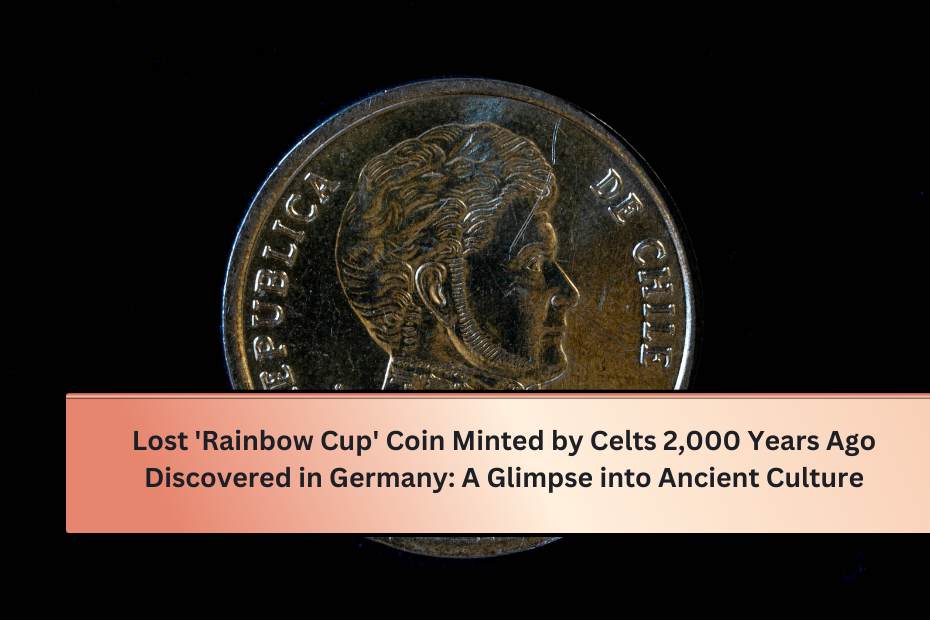Recently, archaeologists in Germany made an exciting discovery: a rare Celtic coin called the “rainbow cup.” This find gives us a peek into the art and trade practices of the Celts, a group of ancient people who lived in Europe. The coin not only tells us about their culture but also reminds us of the importance of studying history. Let’s explore what makes this discovery so significant and what it reveals about the lives of the Celts.
The Discovery of the Rainbow Cup Coin
The story of the rainbow cup coin begins in a small area of Germany. A group of amateur archaeologists went out for a metal-detecting adventure. After searching for several hours, they found something unusual: a coin with beautiful designs. At first, it looked like just another artifact, but after checking it closely, they realized it was a rare coin made by the Celts around 2,000 years ago.
This coin is called the “rainbow cup” because of its unique pictures and craftsmanship. It was discovered near a place where many Celtic artifacts have been found. The site was close to an old Celtic settlement, making it a promising area for historical discoveries. As experts looked at the coin, they understood that this was not just a simple item; it was a piece of history that had been hidden for a long time.
The Historical Context of the Celts
To understand the significance of the rainbow cup coin, we must know more about the Celts and their culture. The Celts were a group of tribal societies that lived in various parts of Europe, especially during the Iron Age and the Roman period. They are famous for their unique art, myths, and social structures, which were different across various tribes.
Celtic culture thrived from about 800 BCE until the Romans took over in the 1st century CE. The Celts were skilled craftsmen known for their detailed metalwork, pottery, and textiles. They also had a rich storytelling tradition, sharing tales about their gods and heroes.
The Significance of Coinage
The introduction of coins was a big change in how the Celts traded and did business. Before coins, people mostly exchanged goods directly. However, with the arrival of coins, it became easier to trade over long distances, allowing different tribes and cultures to interact more economically.
Like other Celtic coins, the rainbow cup coin was not just a way to trade; it also had cultural meaning. The designs on the coin often reflected the beliefs and identities of the tribes that made them. Coins sometimes celebrated important events, leaders, or gods, making them a vital part of Celtic culture.
Features of the Rainbow Cup Coin
The rainbow cup coin is especially remarkable for its detailed design and craftsmanship. One side of the coin shows a carefully crafted depiction of a cup surrounded by flowing lines that look like a rainbow. This image likely symbolizes plenty and celebration, which were important in Celtic culture.
On the other side of the coin, there are various symbols typical of Celtic art, such as spirals, knots, and animal images. These designs are not only beautiful but also hold deeper meanings. For example, spirals often symbolize the cycle of life, while animal images may represent traits like strength or wisdom.
The artistry of the rainbow cup coin shows how skilled the Celts were. The ability to mint coins with such detail and precision suggests they had advanced knowledge of metalwork and design. It also indicates that the Celts were part of complex trade systems and had talented artisans who could create high-quality items.
The Journey of the Coin: From Minting to Discovery
The journey of the rainbow cup coin is fascinating and spans many centuries. After it was made, the coin likely circulated among different tribes, serving as a tool for trade and cultural exchange. As the Celts interacted with other cultures, such as the Romans and Germanic tribes, the coin played a role in economic transactions and building relationships.
Over time, however, the coin was lost to history. Its disappearance could be due to changes in trade routes, the decline of Celtic societies, or the Roman conquest of Celtic lands. As the Romans spread their influence, many Celtic artifacts, including coins, were destroyed or buried, leaving little evidence of their existence.
The rainbow cup coin remained hidden for hundreds of years until its recent discovery. This find not only reconnects us with the past but also emphasizes the importance of archaeological work in uncovering the stories of ancient cultures.
The Archaeological Process and Findings
After finding the rainbow cup coin, archaeologists conducted a thorough excavation of the area. This process involved carefully digging to discover more artifacts and details related to the find. Such excavations are essential for understanding the historical significance of the coin and its place in Celtic culture.
During the dig, researchers found several other items alongside the coin, including pottery pieces, tools, and what looked like parts of a ceremonial site. These discoveries give us valuable insights into the daily lives, rituals, and trade practices of the Celts. By studying the context where the rainbow cup coin was found, archaeologists can create a clearer picture of Celtic society.
The Role of Technology in Archaeology
Modern technology has greatly helped in analyzing and preserving the rainbow cup coin. Advanced imaging techniques, like 3D scanning and digital modeling, allow researchers to create detailed representations of the coin without damaging it. These technologies also help share findings with more people, increasing public interest in archaeology.
Additionally, scientific tests, including metallurgical analysis, help researchers understand the coin’s material and the methods used to make it. These analyses can reveal information about trade networks and technological advancements during that time.
Cultural Impact and Public Interest
The discovery of the rainbow cup coin has sparked significant public interest and excitement. The story of the coin’s rediscovery has fascinated history lovers, collectors, and the general public. Many see it as a direct connection to the past, igniting curiosity about Celtic culture and ancient European history.
Local museums and cultural institutions have taken notice of this find, organizing exhibitions and educational programs to highlight the importance of the rainbow cup coin. These initiatives aim to engage the community in conversations about archaeology, history, and the need to preserve our cultural heritage.
Media coverage of the find has also raised awareness about Celtic history and the broader context of ancient European societies. Documentaries, articles, and social media campaigns have helped share the story of the rainbow cup coin with people all over the world.
The Future of the Rainbow Cup Coin
As researchers continue to study the rainbow cup coin, its future looks bright. Experts believe that ongoing research will uncover new details about its history and the cultural practices of the Celts. This coin may also inspire more archaeological efforts in the area, leading to the discovery of additional artifacts and sites.
Once the research is completed, the coin will likely be displayed in a museum, allowing the public to see this extraordinary piece of history. Such exhibitions provide an opportunity for people to connect with the past and appreciate the art and skill of ancient cultures.
Conclusion
The discovery of the lost rainbow cup coin, minted by the Celts 2,000 years ago in Germany, serves as a powerful reminder of our shared human heritage. This remarkable find not only reveals the intricate artistry and trade practices of the Celts but also emphasizes the importance of preserving our historical artifacts for future generations.
Exploring the stories behind such discoveries helps us understand the diverse cultures that have shaped our world. The rainbow cup coin, with its intricate design and rich history, stands as a testament to the creativity and resilience of the Celtic people. It invites us to explore the past, celebrate our shared history, and recognize the value of cultural heritage in our lives today.
FAQs
1. What is the “rainbow cup” coin?
The “rainbow cup” coin is a rare Celtic coin minted around 2,000 years ago. It is named for its unique design, which features a depiction of a cup surrounded by flowing lines resembling a rainbow. This coin offers insights into the artistry, trade practices, and cultural values of the Celts.
2. Where was the rainbow cup coin discovered?
The coin was discovered in a rural area of Germany by a group of amateur archaeologists during a metal-detecting expedition. The find occurred near a site that was once a Celtic settlement, which is known for its archaeological significance.
3. What do the designs on the rainbow cup coin mean?
The designs on the rainbow cup coin are rich in symbolism. The cup symbolizes abundance and celebration, reflecting the importance of feasting in Celtic culture. Other elements, such as spirals and animal motifs, represent life cycles, strength, and wisdom, all important aspects of Celtic beliefs.
4. How does this discovery contribute to our understanding of Celtic culture?
The discovery of the rainbow cup coin helps historians and archaeologists understand the trade practices, social structures, and artistic achievements of the Celts. It reveals how they interacted with other cultures, including the Romans, and how they used coinage to facilitate trade and express their identity.
5. What happens to the rainbow cup coin now that it has been found?
After thorough research and analysis, the rainbow cup coin is expected to be displayed in a museum. This will allow the public to appreciate this remarkable artifact and learn more about Celtic history and culture. Ongoing studies may also uncover further insights into its history and the society that created it.

